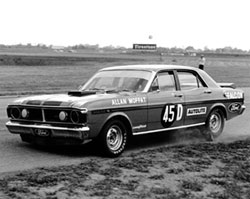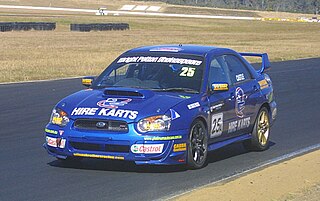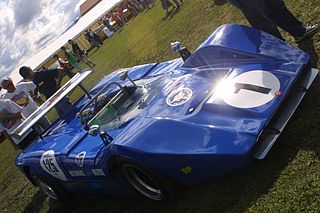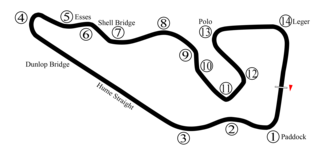
Formula Two, abbreviated to F2, also called Formula 2, is a type of open-wheel formula racing category first codified in 1948. It was replaced in 1985 by Formula 3000, but revived by the FIA from 2009–2012 in the form of the FIA Formula Two Championship. The name returned in 2017 when the former GP2 Series became known as the FIA Formula 2 Championship.

The Tasman Series was a motor racing competition held annually from 1964 to 1975 over a series of races in New Zealand and Australia. It was named after the Tasman Sea which lies between the two countries. The Tasman Series races were held in January through to late February or early March of each year, during the Formula One off season, taking advantage of winter in the Northern Hemisphere to attract many top drivers to summer in the south. The Tasman Cup was the permanent trophy awarded to the winning driver.

Australian Formula 2, sometimes abbreviated to AF2 or ANF2, is a "wings and slicks" formula racing category in Australia. The category is one of Australia's oldest, dating back to 1964. The current format of AF2 was introduced in 1978. Brian Shead of Cheetah Racing Cars and Garrie Cooper of Elfin Racing Cars were largely responsible for the development of the format, which was devised to suit the needs of Australian drivers, most of whom had little or no sponsorship and had to bear the costs of racing out of their own pockets.
The Australian Super Touring Championship was a CAMS-sanctioned national motor racing title for Super Touring Cars.

Australian Formula 3 has been the name applied to two distinctly different motor racing categories, separated by over twenty years.
Formula Pacific was a motor racing category which was used in the Pacific Basin area from 1977 to 1982. It specified a single-seat, open-wheeler chassis powered by a production-based four-cylinder engine of under 1600cc capacity. The formula was based on Formula Atlantic, with provision made for the use of Japanese engines. The category was superseded in 1983 by Formula Mondial, which was devised by the FIA to replace both Formula Atlantic and Formula Pacific.
The 1964 Australian Drivers' Championship was open to drivers of Racing Cars complying with either the Australian National Formula or with the Australian 1½ Litre Formula. The title was contested over a five-round series.
The Australian One and a Half Litre Championship was a CAMS sanctioned national motor racing title contested annually from 1964 to 1968. It was open to drivers of cars complying with the Australian 1½ Litre Formula which specified open wheel racing cars fitted with unsupercharged engines using commercially available fuel and limited to 1500cc capacity. The title was staged over a single race in the first two years and over a series of races in the last three.

Australian Formula 1 (AF1) was a motor sport category for open-wheeler racing cars which was current in Australia from 1970 to 1983.
The 1989 Australian Drivers' Championship was an Australian motor racing competition open to racing cars complying with CAMS Formula Holden regulations. The championship winner was awarded the 1989 CAMS Gold Star as the Australian Drivers' Champion. It was the 33rd running of the Australian Drivers' Championship and the first to feature the Formula Holden class which had been developed during 1988, originally named Formula Australia.
The Australian 1½ Litre Formula was a motor racing category which was current in Australia from 1964 to 1968. The formula specified racing cars with four-cylinder unsupercharged engines using commercially available fuel and limited to 1500cc capacity. It occupied the second tier in Australian formula car racing, below the Australian National Formula and above Australian Formula 2 (1100cc) and Australian Formula 3 (1000cc).

Group E Series Production Touring Cars was an Australian motor racing category for production based sedans competing with limited modifications. It was current from 1964 to 1972.

Group 3E Series Production Cars is an Australian motor racing formula for production based cars competing with limited modifications. Group 3E cars formerly contested the Australian Manufacturers' Championship and Australian Production Car Championship titles and compete in the annual Bathurst 12 Hour and Bathurst 6 Hour endurance races.

Group A Sports Cars is an Australian motor racing category that CAMS formulated for sports car racing in Australia. Introduced in 1964, it continues today under the name Group 2A Sports Cars.

The 1964 Australian One and a Half Litre Championship was a CAMS sanctioned motor racing title for drivers of Australian 1½ Litre Formula racing cars. The title was contested over a 34 lap, 76½ miles (123 km) race held at the Warwick Farm circuit in New South Wales, Australia on 6 September 1964. This was the first national title for the Australian 1½ Litre Formula which was in its first year of existence.
Formula Mondial was an international motor racing category which was introduced to replace both Formula Atlantic and the similar Formula Pacific in 1983.
The 1997 Australian Drivers' Championship was a motor racing competition open to drivers of racing cars complying with CAMS Formula Holden regulations. The championship winner was awarded the 1997 CAMS Gold Star as the Australian Drivers' Champion. It was the 41st running of the Australian Drivers' Championship, and the ninth to feature the Formula Holden category which had been developed during 1988. The championship began on 15 March 1997 at the Calder Park Raceway and ended on 3 August at Oran Park Raceway after seven rounds of a series which was promoted as the "Holden Australian Drivers Championship".
The 1968 Australian Drivers' Championship was a CAMS-sanctioned national motor racing title open to racing cars complying with the Australian National Formula or the Australian 1½ Litre Formula. The title was contested over a six-race series, with the winner awarded the 1968 CAMS Gold Star.
The 1971 Australian Drivers’ Championship was a CAMS sanctioned motor racing title open to Australian Formula 1 and Australian Formula 2 racing cars. It was the fifteenth Australian Drivers' Championship and the first to feature cars complying with a new for 1971 Australian Formula 1 which permitted cars with production based V8 engines of up to 5 litre capacity or racing engines of up to eight cylinders and up to 2 litre capacity. The championship winner was awarded the 1971 CAMS Gold Star and the title of Australian Champion Driver.
The 1985 Australian Sports Car Championship was a CAMS sanctioned motor racing title for drivers of Group A Sports Cars. It was the 17th Australian Sports Car Championship and the first to be run concurrently with the Australian GT Championship.









